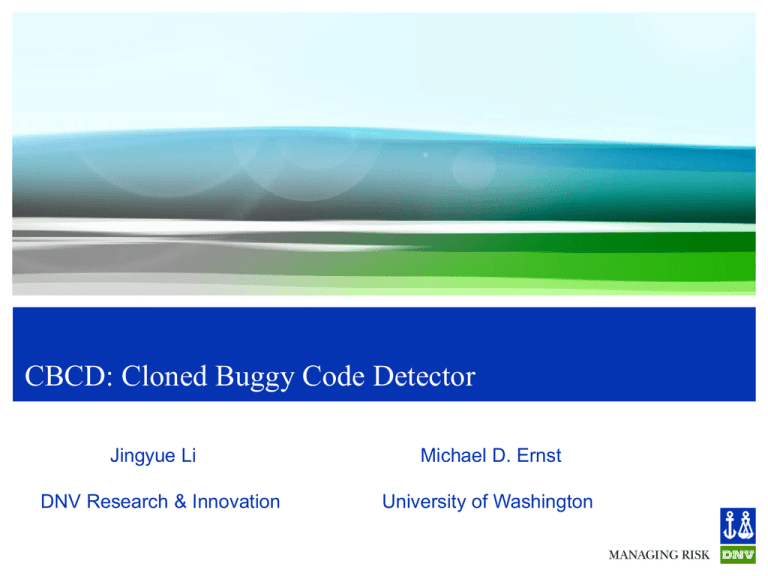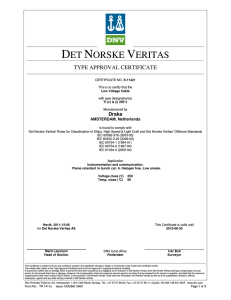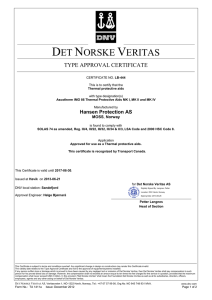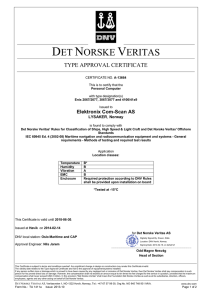
CBCD: Cloned Buggy Code Detector
Jingyue Li
DNV Research & Innovation
Michael D. Ernst
University of Washington
Overview
Cut-and-paste happens
An empirical study of cloned buggy code
•
•
4% of bugs are cloned in a commercial system
350 cloned bugs in Open Source Software
CBCD - A tool to detect cloned buggy code
(Optimizations of Program Dependency Graph based clone detection
for finding bugs and for scaling)
CBCD Evaluation
CBCD outperformed 4 clone detectors for this task
CBCD: Cloned Buggy Code Detector
© Det Norske Veritas AS. All rights reserved.
2
An empirical study of cloned buggy code
CBCD: Cloned Buggy Code Detector
© Det Norske Veritas AS. All rights reserved.
3
Have bugs been cloned?
Investigated systems
- Linux kernel (OSS): millions of LOC
- Git version control system (OSS): > 300 KLOC
- PostgreSQL database (OSS): > 300 KLOC
- A software product line (commercial): > 50 products, > 1 million LOC each
Approach
- We searched for these keywords in bug reports and commit messages:
o “same bug”, “same fix”, “same issue”, “same error”, and “same problem”
- For each match, we manually determined whether the commit was necessitated
by duplication of a bug
- If so, we identified the buggy code and its clones manually
CBCD: Cloned Buggy Code Detector
© Det Norske Veritas AS. All rights reserved.
4
Results of the Empirical Study
OSS
Cloned bugs
Locatable clones
Linux kernel
282
157
Git
33
12
PostgreSQL
33
22
- For some bugs, we could locate their clones, e.g. in the commit, it says
o “This is quite the same fix as in 2cb96f86628d6e97fcbda5fe4d8d74876239834c.”
- For some other bugs, we could not locate their clones, e.g.
o “Other platforms have this same bug, in one form or another.”
Commercial product line
- 969 out of 25420 bugs (3.8%)
- No access to source code
CBCD: Cloned Buggy Code Detector
© Det Norske Veritas AS. All rights reserved.
5
The Buggy Code Segment is Usually Small
More than 88% of the bugs cover 4 or fewer contiguous lines of code
Size (contiguous lines) of the largest component of each bug fix
CBCD: Cloned Buggy Code Detector
© Det Norske Veritas AS. All rights reserved.
6
The Need to Detect Cloned Buggy Code
The empirical study confirmed that cloned bugs do exist
Once a bug is detected, it is necessary to find all its clones and fix them
Customer satisfaction drops when a customer re-encounters a bug that the vendor
claimed to have fixed
Inputs
Output
Buggy code snippet
Entire system to be checked
CBCD: Cloned Buggy Code Detector
© Det Norske Veritas AS. All rights reserved.
7
CBCD - A tool to detect cloned buggy code
CBCD: Cloned Buggy Code Detector
© Det Norske Veritas AS. All rights reserved.
8
CBCD Uses PDG-Based Clone Detection Approach
Clone detection approaches:
- Text-based, Token-based, Abstract Syntax Tree (AST)-based
- Program Dependency Graph (PDG)-based
PDG example
static int add(int a, int b)
{
return(a+b);
}
Control
dependency
Entry: add
a = ain
ret = result
b = bin
Data
dependency
result = a+b
PDG-based clone detection approach
-
Check graph isomorphism of PDGs of code segments to identify code clones
More resilient to code changes
CBCD: check whether PDG of the buggy code is a subgraph of the PDG of the system
Unlike other PDG-based tools, CBCD also requires vertex kind and source text match
CBCD: Cloned Buggy Code Detector
© Det Norske Veritas AS. All rights reserved.
9
CBCD Architecture
Input:
Buggy
lines
Input:
System
to be
checked
Step 1:
Create
Bug
PDG
Step 1:
Create
System
PDG
•
•
Bug
PDG
Bug
vertex Info
Step 2:
Split the
Bug PDG
and prune
the System
PDG
System
vertex Info
Split Bug
PDG
Pruned
System
PDG
Step 3:
Subgraph
testing
(igraph)
Vertex kind and source text are used to prune parts of
System PDG that cannot match
And also used in subgraph testing
CBCD: Cloned Buggy Code Detector
© Det Norske Veritas AS. All rights reserved.
Output:
Bug
clones
System
PDG
•
Codesurfer
Subgraph isomorphism is O(N!N)
We implemented optimizations to reduce N
10
Four Optimizations: Reduce the N in Subgraph Isomorphism
Isomorphism requires graph structure, vertex kind, and source text to match
More than 88% of the bugs cover ≤ 4 lines
1. Prune System PDG
- Compare the start and end vertex kind and
source text of edge of the System and Bug
PDG
2. Break System PDG
- Use vertex kind info. of Bug PDG to
choose only small sections of the System
PDG
3. Exclude irrelevant System PDG
Bug PDG
radius = 2
4. Break Bug PDG
System PDG
CBCD: Cloned Buggy Code Detector
© Det Norske Veritas AS. All rights reserved.
11
CBCD evaluation
CBCD: Cloned Buggy Code Detector
© Det Norske Veritas AS. All rights reserved.
12
CBCD Evaluation and Comparison with Clone Detectors
Research questions:
- How well can CBCD find cloned buggy code?
- How well does CBCD scale?
Oracle for the evaluation
- 53 bugs (34 Linux kernel, 5 Git, and 14 PostgreSQL) and their clones
Evaluation environment
o Ubuntu 10.04, 4G Mem, 3Ghz CPU
Clone detectors under comparison
- CBCD (PDG-based)
- Simian (text-based)
- CCFinder (token-based)
- Decard (AST-based)
- CloneDr (AST-based)
CBCD: Cloned Buggy Code Detector
© Det Norske Veritas AS. All rights reserved.
13
How Well Can CBCD Find Cloned Buggy Code?
For each investigated bug and each of its clone, we check if a tool reports
- False Negative (FN): A clone is identified by the developer, but not by the tool.
- False Positive (FP): A clone is repored by the tool, but not by developers as buggy.
Each of the 53 investigated bugs falls into one of four categories
* Only 2% of the input files and 1% of the lines of code
General clone detectors and CBCD are designed for different purposes
- General clone detectors are good at finding large code clones
- CBCD is more like an advanced “Find” command, good at finding small code clones
CBCD: Cloned Buggy Code Detector
© Det Norske Veritas AS. All rights reserved.
14
Advantages and Limitations of CBCD
Advantages: As expected, CBCD is more resilient to some types of code changes
o Code deletions or insertions that do not change the PDG
o Reordering of statements
o Control-statement replacement
Limitations
- False Positive : when the buggy code is a one-line function call
o Buggy code: memset(ib_ah_attr, 0, sizeof *path);
o True positive: memset(ib_ah_attr, 0, sizeof *path);
o False positive: memset(p, 0, padding);
- False Negative: Buggy code is in data structure or marcos, due to limitations of CodeSurfer.
- False Negative: Variable renaming in an expression, because CBCD limits such renaming
o Buggy code: if (!hpet && !ref1 && !ref2)
o True positive: if (!hpet && !ref_start && !rf_stop)
CBCD: Cloned Buggy Code Detector
© Det Norske Veritas AS. All rights reserved.
15
How well does CBCD scale?
<47 seconds to find clones of a bug in a system having ≥ 400 KNLOC,
after the system PDG is generated by CodeSurfer
Generating system PDG from CodeSurfer is the bottleneck
- However, this step needs to be done only once and is reusable
The optimizations are effective
- Most effective: Prune System PDG
o Pruned 90% of the edges
o 20237 and 11890 performance improvement in two cases
o Avoid “out-of-memory” error due to too big System PDG in another case
- Other optimizations provide moderate performance gains
CBCD: Cloned Buggy Code Detector
© Det Norske Veritas AS. All rights reserved.
16
Conclusions
Examined real-world bug reports
Established that identical (cloned) bugs are a serious problem
Proposed that programmer should search for clones of buggy code
Optimizations to PDG-based clone detection algorithms for scalability
Implemented CBCD, a PDG-based tool that detects possible clones of buggy code
CBCD is scalable, effective, and outperforms other tools for this task
Finding cloned bugs is very important, and now a tool (CBCD) exists for that!
CBCD: Cloned Buggy Code Detector
© Det Norske Veritas AS. All rights reserved.
17





